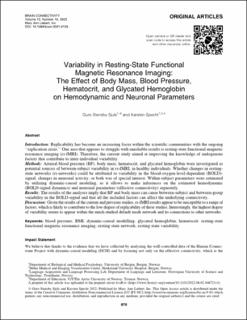| dc.contributor.author | Sjuls, Guro Stensby | |
| dc.contributor.author | Specht, Karsten | |
| dc.date.accessioned | 2023-02-01T13:03:51Z | |
| dc.date.available | 2023-02-01T13:03:51Z | |
| dc.date.created | 2023-01-06T13:03:13Z | |
| dc.date.issued | 2022 | |
| dc.identifier.issn | 2158-0014 | |
| dc.identifier.uri | https://hdl.handle.net/11250/3047740 | |
| dc.description.abstract | Introduction: Replicability has become an increasing focus within the scientific communities with the ongoing “replication crisis.” One area that appears to struggle with unreliable results is resting-state functional magnetic resonance imaging (rs-fMRI). Therefore, the current study aimed at improving the knowledge of endogenous factors that contribute to inter-individual variability.
Methods: Arterial blood pressure (BP), body mass, hematocrit, and glycated hemoglobin were investigated as potential sources of between-subject variability in rs-fMRI, in healthy individuals. Whether changes in resting-state networks (rs-networks) could be attributed to variability in the blood-oxygen-level-dependent (BOLD)-signal, changes in neuronal activity, or both was of special interest. Within-subject parameters were estimated by utilizing dynamic-causal modeling, as it allows to make inferences on the estimated hemodynamic (BOLD-signal dynamics) and neuronal parameters (effective connectivity) separately.
Results: The results of the analyses imply that BP and body mass can cause between-subject and between-group variability in the BOLD-signal and that all the included factors can affect the underlying connectivity.
Discussion: Given the results of the current and previous studies, rs-fMRI results appear to be susceptible to a range of factors, which is likely to contribute to the low degree of replicability of these studies. Interestingly, the highest degree of variability seems to appear within the much-studied default mode network and its connections to other networks. | en_US |
| dc.language.iso | eng | en_US |
| dc.publisher | Mary Ann Liebert, Inc. | en_US |
| dc.rights | Navngivelse-Ikkekommersiell 4.0 Internasjonal | * |
| dc.rights.uri | http://creativecommons.org/licenses/by-nc/4.0/deed.no | * |
| dc.title | Variability in Resting-State Functional Magnetic Resonance Imaging: The Effect of Body Mass, Blood Pressure, Hematocrit, and Glycated Hemoglobin on Hemodynamic and Neuronal Parameters | en_US |
| dc.type | Journal article | en_US |
| dc.type | Peer reviewed | en_US |
| dc.description.version | publishedVersion | en_US |
| dc.rights.holder | Copyright 2022 The Author(s) | en_US |
| cristin.ispublished | true | |
| cristin.fulltext | original | |
| cristin.qualitycode | 1 | |
| dc.identifier.doi | 10.1089/brain.2021.0125 | |
| dc.identifier.cristin | 2102057 | |
| dc.source.journal | Brain Connectivity | en_US |
| dc.source.pagenumber | 870-882 | en_US |
| dc.identifier.citation | Brain Connectivity. 2022, 12 (10), 870-882. | en_US |
| dc.source.volume | 12 | en_US |
| dc.source.issue | 10 | en_US |

